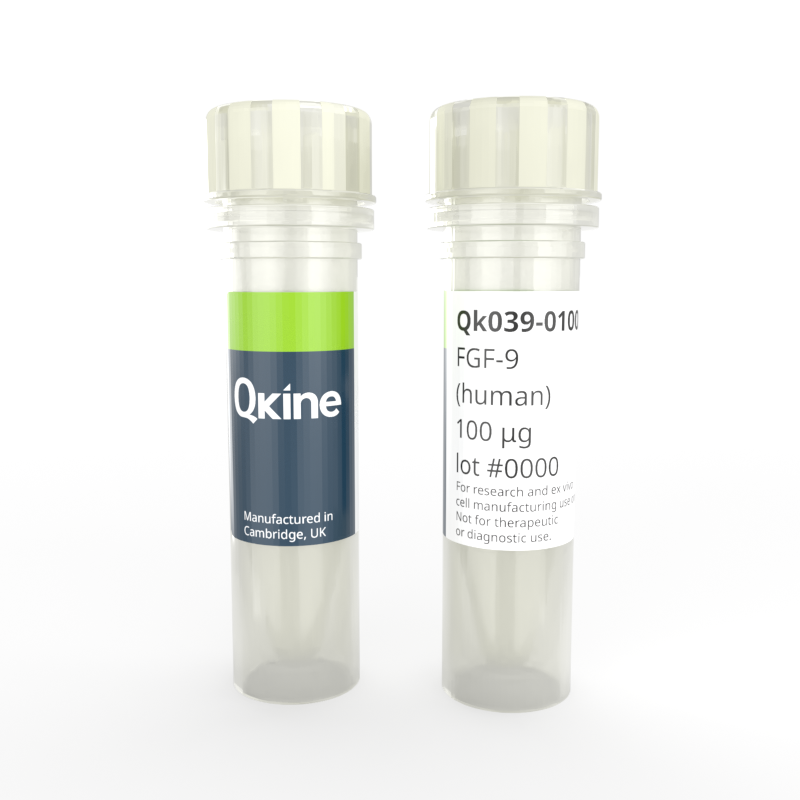Recombinant human FGF-9 protein
QK039
Brand: Qkine
Human FGF-9 protein is a member of the fibroblast growth factor (FGF) family, FGF-9 is involved in many developmental processes including neural and skeletal development. Recombinant FGF-9 is used frequently in the generation of kidney organoids.
Qkine recombinant human FGF-9 is a highly pure and bioactive 23 kDa protein, animal origin-free (AOF) and carrier-protein free (CF).

Currency:
| Product name | Catalog number | Pack size | Price | Price (USD) | Price (GBP) | Price (EUR) |
|---|---|---|---|---|---|---|
| Recombinant human/mouse/rat follistatin-resistant activin A (FRACTA) protein, 25 µg | QK035-0025 | 25 µg | (select above) | $ 280.00 | £ 205.00 | € 240.00 |
| Recombinant human/mouse/rat follistatin-resistant activin A (FRACTA) protein, 50 µg | QK035-0050 | 50 µg | (select above) | $ 410.00 | £ 305.00 | € 357.00 |
| Recombinant human/mouse/rat follistatin-resistant activin A (FRACTA) protein, 100 µg | QK035-0100 | 100 µg | (select above) | $ 620.00 | £ 455.00 | € 532.00 |
| Recombinant human/mouse/rat follistatin-resistant activin A (FRACTA) protein, 500 µg | QK035-0500 | 500 µg | (select above) | $ 2,500.00 | £ 1,840.00 | € 2,150.00 |
| Recombinant human/mouse/rat follistatin-resistant activin A (FRACTA) protein, 1000 µg | QK035-1000 | 1000 µg | (select above) | $ 3,950.00 | £ 2,900.00 | € 3,388.00 |
Note: prices shown do not include shipping and handling charges.
Qkine company name and logo are the property of Qkine Ltd. UK.
Alternative protein names
Species reactivity
human
species similarity:
mouse – 99%
rat – 99%
bovine – 98%
porcine – 98%
Frequently used together:
Summary
- High purity optimized human FGF-9 protein (Uniprot: P31371)
- 23 kDa (monomer)
- >98%, by SDS-PAGE quantitative densitometry
- Expressed in E. coli
- Animal origin-free (AOF) and carrier protein-free
- Manufactured in Qkine's Cambridge, UK laboratories
- Lyophilized from HEPES, NaCl
- Resuspend in sterile-filtered water at >50 µg/ml, add carrier protein if desired, prepare single use aliquots and store frozen at -20 °C (short-term) or -80 °C (long-term).
Featured applications
- Kidney organoid generation
- Chemically defined media
Bioactivity
FGF-9 activity is determined using the Promega serum response element luciferase reporter assay (*) in transfected HEK293T cells. Cells are treated in triplicate with a serial dilution of FGF-9 for 3 hours. Firefly luciferase activity is measured and normalized to the control Renilla luciferase activity. EC50 = 246.2 pM (5.7 ng/mL). Data from Qk039 lot #104295. *Promega pGL4.33[luc2P/SRE/Hygro] #E1340

Purity
FGF-9 protein migrates as a single band at 23 kDa in non-reducing (NR) conditions and upon reduction (R). No contaminating protein bands are visible. Purified recombinant protein (3 µg) was resolved using 15% w/v SDS-PAGE in reduced (+β-mercaptothanol, R) and non-reduced (NR) conditions and stained with Coomassie Brilliant Blue R250. Data from Qk039 lot #104295

Further quality assays
- Mass spectrometry: single species with expected mass
- Analytical reversed-phase: single sharp peak
- Endotoxin: <0.005 EU/μg protein (below level of detection)
- Recovery from stock vial: >95%

Quantitative luciferase assay with Qkine FGF-9 (Qk039, green) and alternative supplier FGF-9 (Supplier B, black). Cells were treated in triplicate with a serial dilution of FGF-9 for 3 hours. Firefly luciferase activity was measured and normalized to control Renilla luciferase activity.
Protein background
Part of thefibroblast growth factor(FGF) family, FGF-9 is a growth factor that has been implicated in many developmental processes, including in lung [1] and skeletal [2] development, sex determination [3], and neural patterning in the optic neuroepithelium [4]. Also known as glia-activating factor, FGF-9 also modulates the development and survival of neurons and glia and has been reported to play pro-survival roles (enhances cell proliferation, and alleviating cell death) in neurodegenerative diseases, such as Parkinson’s disease, Huntington’s Disease and Alzheimer’s disease [5]. FGF-9 protein is commonly used in the generation of kidneyorganoids[6].
FGF-9 protein binds and activates the ‘c’ splice isoform of FGF receptor 1–3 [7], and can activate a number of signalling pathways, such as ERK, STAT, PI3K and MAP kinase pathways.
Background references
- Yin, Y., Wang, F. & Ornitz, D. M. Mesothelial- and epithelial-derived FGF9 have distinct functions in the regulation of lung development. Development 138, 3169–3177 (2011).doi: 10.1242/dev.065110
- Hung, I. H., Schoenwolf, G. C., Lewandoski, M. & Ornitz, D. M. A combined series of Fgf9 and Fgf18 mutant alleles identifies unique and redundant roles in skeletal development. Dev Biol 411, 72–84 (2016).doi: 10.1016/j.ydbio.2016.01.008
- Schmahl, J., Kim, Y., Colvin, J. S., Ornitz, D. M. & Capel, B. Fgf9 induces proliferation and nuclear localization of FGFR2 in Sertoli precursors during male sex determination. Development 131, 3627–3636 (2004).doi: 10.1242/dev.01239
- Zhao, S. et al. Patterning the optic neuroepithelium by FGF signaling and Ras activation. Development 128, 5051–5060 (2001).doi.org/10.1242/dev.128.24.5051
- Yusuf, I. O. et al. Fibroblast Growth Factor 9 Suppresses Striatal Cell Death Dominantly Through ERK Signaling in Huntington’s Disease. Cell Physiol Biochem 48, 605–617 (2018).doi: 10.1159/000491889
- Morizane, R. & Bonventre, J. V. Kidney Organoids: A Translational Journey. Trends in Molecular Medicine 23, 246–263 (2017).doi: 10.1016/j.molmed.2017.01.001
- Liu, Y. et al. Regulation of Receptor Binding Specificity of FGF9 by an Autoinhibitory Homodimerization. Structure 25, 1325-1336.e3 (2017).doi: 10.1016/j.str.2017.06.016